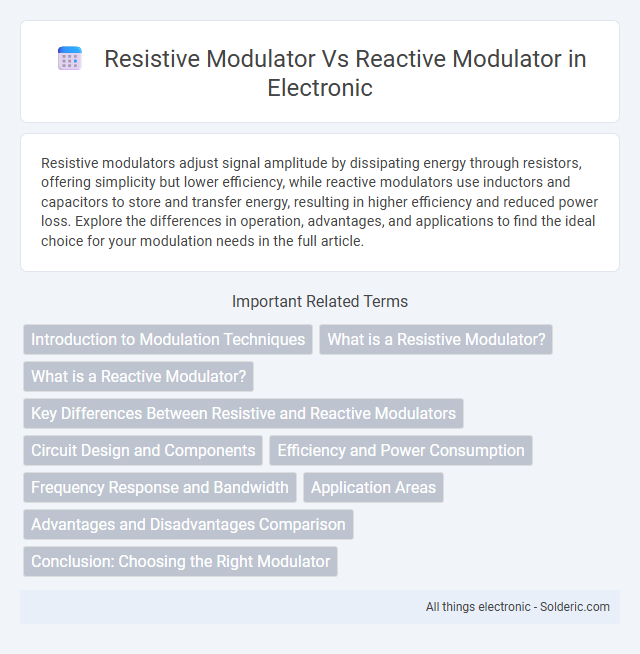Resistive modulators adjust signal amplitude by dissipating energy through resistors, offering simplicity but lower efficiency, while reactive modulators use inductors and capacitors to store and transfer energy, resulting in higher efficiency and reduced power loss. Explore the differences in operation, advantages, and applications to find the ideal choice for your modulation needs in the full article.
Comparison Table
| Feature | Resistive Modulator | Reactive Modulator |
|---|---|---|
| Operating Principle | Modulation via variable resistance | Modulation via variable reactance (inductance or capacitance) |
| Power Efficiency | Generally lower due to resistive losses | Higher, as reactive components store and release energy |
| Insertion Loss | Higher insertion loss | Lower insertion loss |
| Linearity | Usually less linear | Typically more linear |
| Frequency Response | Broadband capable but lossy | Frequency selective but efficient |
| Heat Dissipation | Significant heat generation | Minimal heat generation |
| Applications | Simple modulation, low-cost designs | High-performance RF and microwave systems |
Introduction to Modulation Techniques
Resistive modulators control amplitude by varying resistance to modulate signal strength, making them suitable for amplitude modulation (AM) applications with straightforward implementation. Reactive modulators manipulate inductance or capacitance to change phase or frequency, essential in phase modulation (PM) and frequency modulation (FM) systems for improved signal fidelity. Both techniques play a critical role in communication systems by enabling effective transmission of information through electrical signal alterations.
What is a Resistive Modulator?
A Resistive Modulator controls signal amplitude by varying resistance within an electronic circuit, resulting in linear attenuation without phase shift. It is commonly used in radio frequency (RF) and communication systems to adjust signal levels efficiently. Your system benefits from the resistive modulator's simplicity and minimal distortion in amplitude modulation tasks.
What is a Reactive Modulator?
A reactive modulator controls signal amplitude by varying the reactance in a circuit, such as inductance or capacitance, rather than dissipating energy like a resistive modulator. This approach improves efficiency by minimizing power loss through energy storage and release rather than resistive heating. Understanding the advantages of a reactive modulator can help optimize your signal modulation for better performance and reduced energy consumption.
Key Differences Between Resistive and Reactive Modulators
Resistive modulators control signal amplitude by varying resistance, resulting in power dissipation and heat generation, while reactive modulators adjust reactance to alter signal phase or frequency with minimal energy loss. Resistance-based modulation often leads to lower efficiency due to continuous power consumption, whereas reactive modulation improves energy efficiency and signal integrity by storing and releasing energy in reactive components. Your choice between these modulators depends on the application's power constraints, signal quality requirements, and thermal management considerations.
Circuit Design and Components
Resistive modulators utilize variable resistors or semiconductor devices to control signal amplitude through power dissipation, often leading to simpler circuit designs but higher energy loss. Reactive modulators rely on inductors, capacitors, or varactors to adjust signal properties by storing and releasing energy, resulting in more complex circuits that offer higher efficiency and lower distortion. Your choice depends on the trade-off between straightforward resistive components and the precise, high-quality performance provided by reactive elements.
Efficiency and Power Consumption
Resistive modulators convert electrical signals by dissipating energy as heat, resulting in lower efficiency and higher power consumption compared to reactive modulators, which use energy-storing elements like inductors and capacitors to transfer energy with minimal losses. Reactive modulators can achieve higher energy efficiency by recycling reactive power, significantly reducing your device's overall power consumption and thermal management requirements. Choosing a reactive modulator improves system performance in applications where power efficiency is critical.
Frequency Response and Bandwidth
Resistive modulators typically exhibit a flat frequency response and broad bandwidth due to their reliance on resistive elements that do not introduce significant reactance, making them suitable for wideband applications. Reactive modulators, incorporating inductors and capacitors, tend to have frequency-dependent impedance, resulting in a limited bandwidth and resonant frequency response that can enhance or attenuate signals at specific frequencies. Consequently, resistive modulators offer more uniform performance across a wide frequency range, whereas reactive modulators provide frequency-selective modulation beneficial for narrowband or tunable systems.
Application Areas
Resistive modulators are commonly used in applications requiring amplitude modulation and signal attenuation, such as audio processing and power control systems. Reactive modulators excel in frequency or phase modulation tasks, making them ideal for radio frequency communications, radar systems, and signal synthesis. Your choice between these modulators depends on the specific application demands for signal integrity and modulation type.
Advantages and Disadvantages Comparison
Resistive modulators offer simplicity and broadband operation but suffer from higher power loss and heat generation due to resistive elements. Reactive modulators excel in energy efficiency with low insertion loss by using capacitive or inductive components yet face challenges in bandwidth limitation and design complexity. Selecting between resistive and reactive modulators depends on application requirements for efficiency, bandwidth, and thermal management.
Conclusion: Choosing the Right Modulator
Resistive modulators offer simplicity and cost-effectiveness, making them ideal for applications requiring straightforward amplitude control with minimal signal distortion. Reactive modulators provide higher efficiency and better linearity by using inductive or capacitive elements, which enhances performance in high-frequency and precision systems. Your choice depends on balancing budget constraints, application requirements, and desired signal quality to optimize system performance.
Resistive modulator vs reactive modulator Infographic

 solderic.com
solderic.com